2017 Peugeot 3008 Hybrid 4 rear battery
[x] Cancel search: rear batteryPage 11 of 566

9
3008-2_en_Chap00b_vue-ensemble_ed01-2016
Technical data - Maintenance
Battery 332-335
Energy economy mode 2 90
Running out of Diesel fuel
3
08
AdBlue
3
7- 40
Checking levels
2
97-300
-
oil
-
b
rake fluid
-
coolant
-
s
creenwash fluid
-
a
dditive (Diesel with particle filter) Petrol engines
3
38 -339
Diesel engines
3
40-343
Dimensions
344
Identification markings
3
45
Checking components
3
01-302
-
battery
-
a
ir filter / passenger
compartment filter
-
o
il filter
-
p
article filter (Diesel)
-
b
rake pads / discs
Changing bulbs
3
23-330
-
front
-
rear Changing a fuse
3
31
Bonnet
2
94
Petrol underbonnet
2
95
Diesel underbonnet
2
96
.
Over view
Page 66 of 566
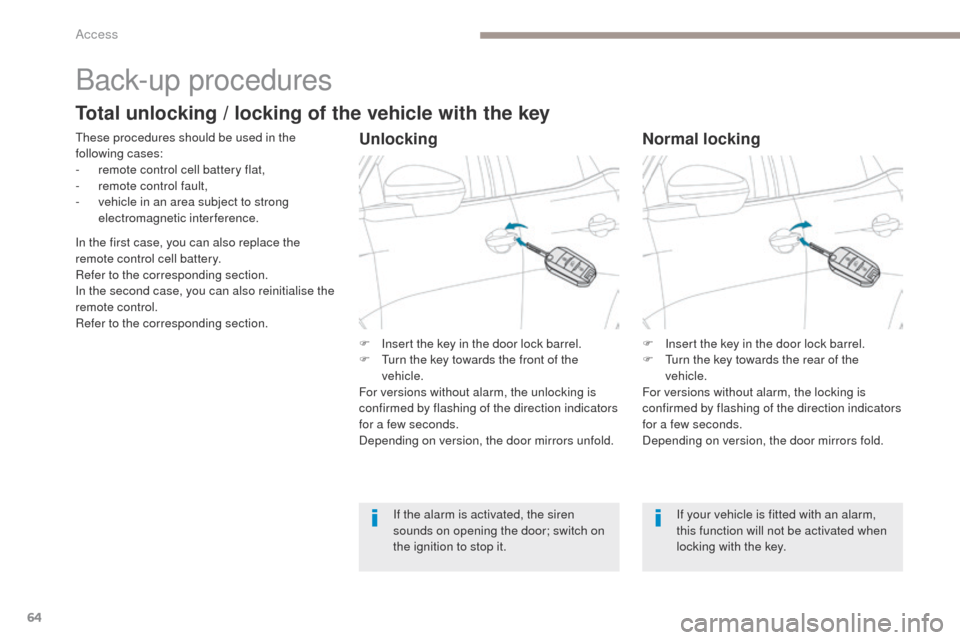
64
3008-2_en_Chap02_ouvertures_ed01-2016
Back-up procedures
These procedures should be used in the
following cases:
-
r
emote control cell battery flat,
-
r
emote control fault,
-
v
ehicle in an area subject to strong
electromagnetic interference.
In the first case, you can also replace the
remote control cell battery.
Refer to the corresponding section.
In the second case, you can also reinitialise the
remote control.
Refer to the corresponding section.Unlocking
F Insert the key in the door lock barrel.
F T urn the key towards the front of the
vehicle.
For versions without alarm, the unlocking is
confirmed by flashing of the direction indicators
for a few seconds.
Depending on version, the door mirrors unfold.
If the alarm is activated, the siren
sounds on opening the door; switch on
the ignition to stop it.
Normal locking
F Insert the key in the door lock barrel.
F T urn the key towards the rear of the
vehicle.
For versions without alarm, the locking is
confirmed by flashing of the direction indicators
for a few seconds.
Depending on version, the door mirrors fold.
If your vehicle is fitted with an alarm,
this function will not be activated when
locking with the key.
Total unlocking / locking of the vehicle with the key
Access
Page 83 of 566
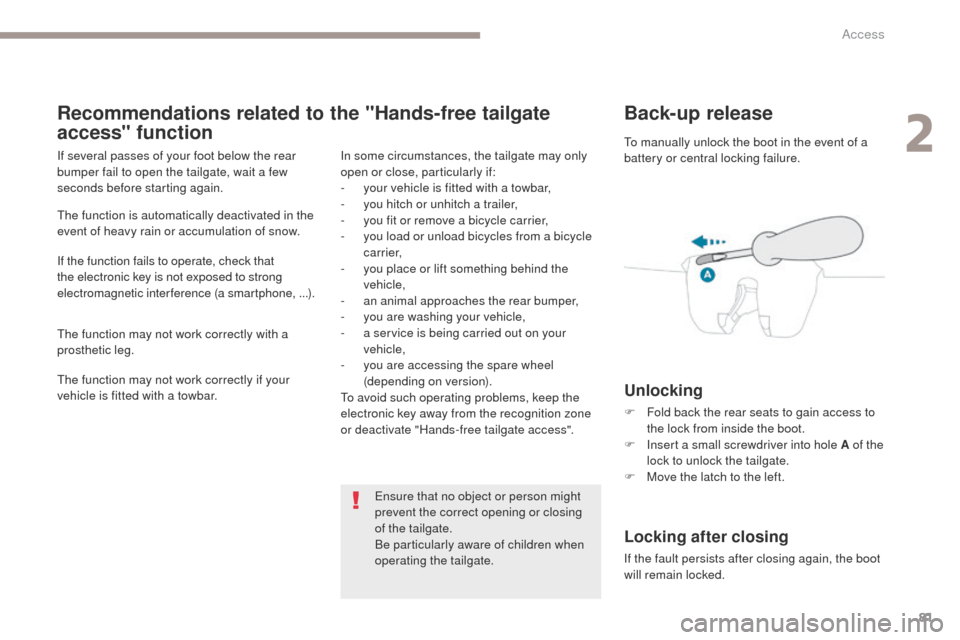
81
3008-2_en_Chap02_ouvertures_ed01-2016
Back-up release
Unlocking
F Fold back the rear seats to gain access to the lock from inside the boot.
F
I
nsert a small screwdriver into hole A of the
lock to unlock the tailgate.
F
M
ove the latch to the left.
Locking after closing
If the fault persists after closing again, the boot
will remain locked. To manually unlock the boot in the event of a
battery or central locking failure.
Recommendations related to the "Hands-free tailgate
access" function
If several passes of your foot below the rear
bumper fail to open the tailgate, wait a few
seconds before starting again.
The function is automatically deactivated in the
event of heavy rain or accumulation of snow.
If the function fails to operate, check that
the electronic key is not exposed to strong
electromagnetic interference (a smartphone, ...).
The function may not work correctly with a
prosthetic leg.
The function may not work correctly if your
vehicle is fitted with a towbar. In some circumstances, the tailgate may only
open or close, particularly if:
-
y
our vehicle is fitted with a towbar,
-
y
ou hitch or unhitch a trailer,
-
y
ou fit or remove a bicycle carrier,
-
y
ou load or unload bicycles from a bicycle
c a r r i e r,
-
y
ou place or lift something behind the
vehicle,
-
an
animal approaches the rear bumper,
-
y
ou are washing your vehicle,
-
a s
ervice is being carried out on your
vehicle,
-
y
ou are accessing the spare wheel
(depending on version).
To avoid such operating problems, keep the
electronic key away from the recognition zone
or deactivate "Hands-free tailgate access".
Ensure that no object or person might
prevent the correct opening or closing
of the tailgate.
Be particularly aware of children when
operating the tailgate.
2
Access
Page 85 of 566
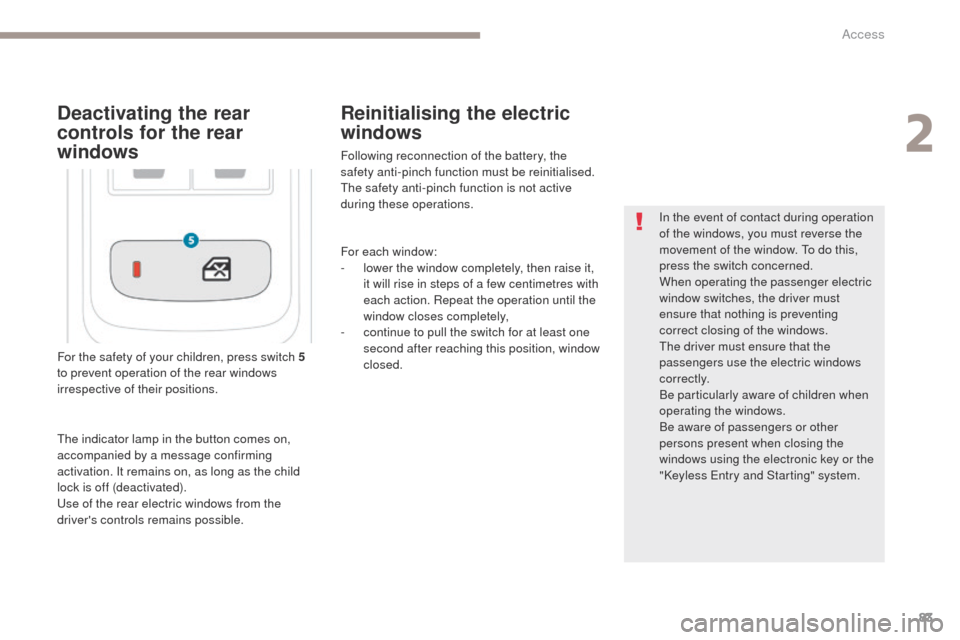
83
3008-2_en_Chap02_ouvertures_ed01-2016
For the safety of your children, press switch 5
t o prevent operation of the rear windows
irrespective of their positions. In the event of contact during operation
of the windows, you must reverse the
movement of the window. To do this,
press the switch concerned.
When operating the passenger electric
window switches, the driver must
ensure that nothing is preventing
correct closing of the windows.
The driver must ensure that the
passengers use the electric windows
c o r r e c t l y.
Be particularly aware of children when
operating the windows.
Be aware of passengers or other
persons present when closing the
windows using the electronic key or the
"Keyless Entry and Starting" system.
Deactivating the rear
controls for the rear
windows
The indicator lamp in the button comes on,
accompanied by a message confirming
activation. It remains on, as long as the child
lock is off (deactivated).
Use of the rear electric windows from the
driver's controls remains possible.
Reinitialising the electric
windows
Following reconnection of the battery, the
safety anti-pinch function must be reinitialised.
The safety anti-pinch function is not active
during these operations.
For each window:
-
l
ower the window completely, then raise it,
it will rise in steps of a few centimetres with
each action. Repeat the operation until the
window closes completely,
-
c
ontinue to pull the switch for at least one
second after reaching this position, window
closed.
2
Access
Page 86 of 566
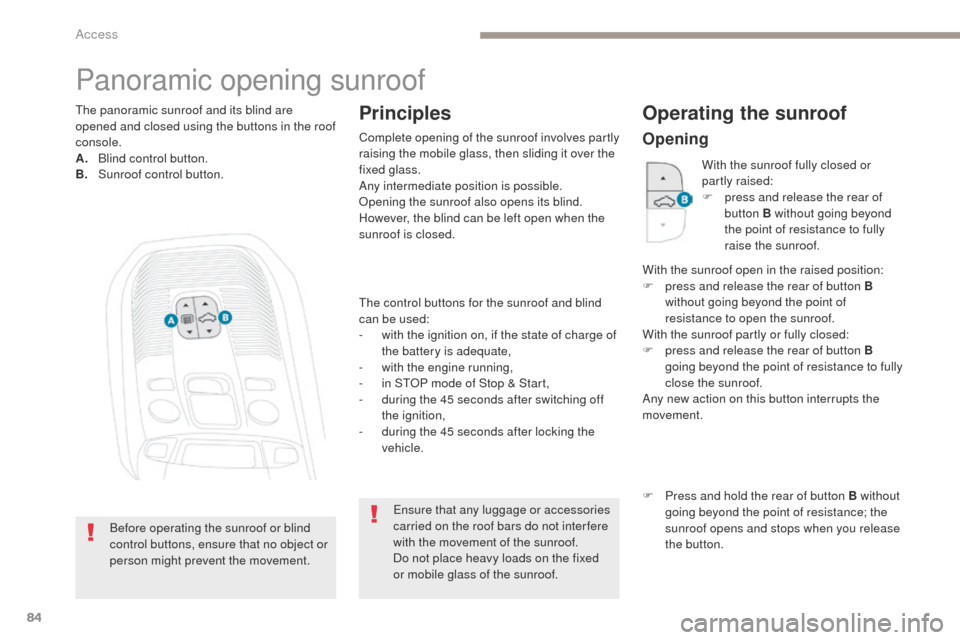
84
3008-2_en_Chap02_ouvertures_ed01-2016
Panoramic opening sunroof
The control buttons for the sunroof and blind
can be used:
-
w
ith the ignition on, if the state of charge of
the battery is adequate,
-
w
ith the engine running,
-
i
n STOP mode of Stop & Start,
-
d
uring the 45 seconds after switching off
the ignition,
-
d
uring the 45 seconds after locking the
vehicle.
Opening
The panoramic sunroof and its blind are
opened and closed using the buttons in the roof
console.
A.
B
lind control button.
B.
S
unroof control button.
Ensure that any luggage or accessories
carried on the roof bars do not inter fere
with the movement of the sunroof.
Do not place heavy loads on the fixed
or mobile glass of the sunroof.
Before operating the sunroof or blind
control buttons, ensure that no object or
person might prevent the movement.Principles
Complete opening of the sunroof involves partly
raising the mobile glass, then sliding it over the
fixed glass.
Any intermediate position is possible.
Opening the sunroof also opens its blind.
However, the blind can be left open when the
sunroof is closed. With the sunroof fully closed or
partly raised:
F
p
ress and release the rear of
button B without going beyond
the point of resistance to fully
raise the sunroof.
With the sunroof open in the raised position:
F
p
ress and release the rear of button B
without going beyond the point of
resistance to open the sunroof.
With the sunroof partly or fully closed:
F
p
ress and release the rear of button B
going beyond the point of resistance to fully
close the sunroof.
Any new action on this button interrupts the
movement.
Operating the sunroof
F Press and hold the rear of button B without going beyond the point of resistance; the
sunroof opens and stops when you release
the button.
Access
Page 87 of 566
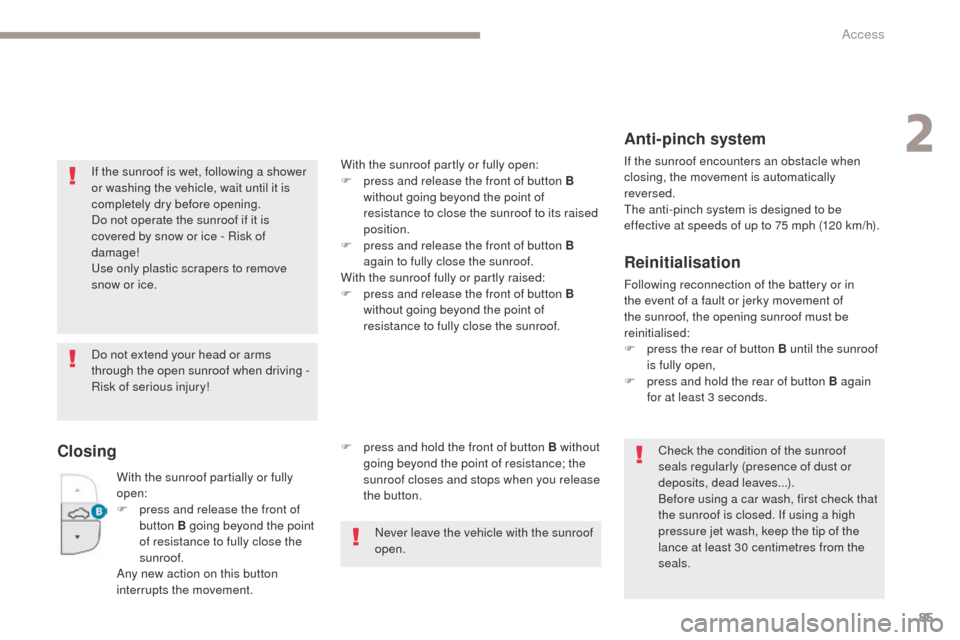
85
3008-2_en_Chap02_ouvertures_ed01-2016
If the sunroof is wet, following a shower
or washing the vehicle, wait until it is
completely dry before opening.
Do not operate the sunroof if it is
covered by snow or ice - Risk of
damage!
Use only plastic scrapers to remove
snow or ice.
Do not extend your head or arms
through the open sunroof when driving -
Risk of serious injury!
ClosingF press and hold the front of button B without going beyond the point of resistance; the
sunroof closes and stops when you release
the button.
Never leave the vehicle with the sunroof
open.
Anti-pinch system
If the sunroof encounters an obstacle when
closing, the movement is automatically
reversed.
The anti-pinch system is designed to be
effective at speeds of up to 75 mph (120 km/h).
Reinitialisation
Following reconnection of the battery or in
the event of a fault or jerky movement of
the sunroof, the opening sunroof must be
reinitialised:
F
p
ress the rear of button B until the sunroof
is fully open,
F
p
ress and hold the rear of button B again
for at least 3 seconds.
Check the condition of the sunroof
seals regularly (presence of dust or
deposits, dead leaves...).
Before using a car wash, first check that
the sunroof is closed. If using a high
pressure jet wash, keep the tip of the
lance at least 30 centimetres from the
seals.
With the sunroof partially or fully
open:
F
p
ress and release the front of
button B going beyond the point
of resistance to fully close the
sunroof.
Any new action on this button
interrupts the movement. With the sunroof partly or fully open:
F
p
ress and release the front of button
B
without going beyond the point of
resistance to close the sunroof to its raised
position.
F
p
ress and release the front of button B
again to fully close the sunroof.
With the sunroof fully or partly raised:
F
p
ress and release the front of button
B
without going beyond the point of
resistance to fully close the sunroof.
2
Access
Page 88 of 566
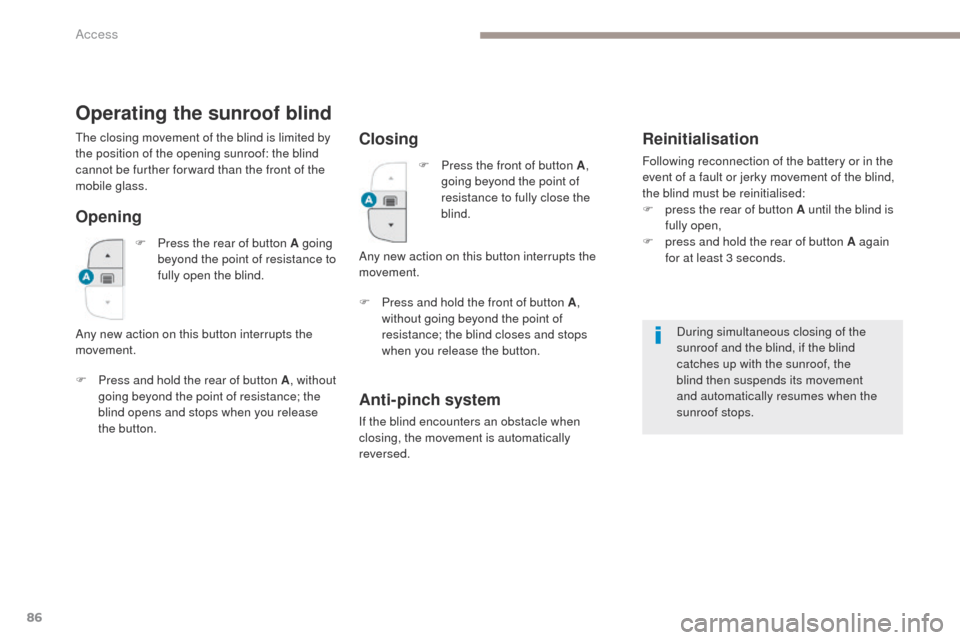
86
3008-2_en_Chap02_ouvertures_ed01-2016
Operating the sunroof blind
Opening
F Press and hold the rear of button A, without
going beyond the point of resistance; the
blind opens and stops when you release
the button. During simultaneous closing of the
sunroof and the blind, if the blind
catches up with the sunroof, the
blind then suspends its movement
and automatically resumes when the
sunroof stops.
The closing movement of the blind is limited by
the position of the opening sunroof: the blind
cannot be further for ward than the front of the
mobile glass.
Closing
Any new action on this button interrupts the
movement.
Anti-pinch system
If the blind encounters an obstacle when
closing, the movement is automatically
reversed.
Reinitialisation
Following reconnection of the battery or in the
event of a fault or jerky movement of the blind,
the blind must be reinitialised:
F
p
ress the rear of button A until the blind is
fully open,
F
p
ress and hold the rear of button A again
for at least 3 seconds.
F
P
ress the rear of button A going
beyond the point of resistance to
fully open the blind.
Any new action on this button interrupts the
movement. F
P
ress the front of button A ,
going beyond the point of
resistance to fully close the
blind.
F
P
ress and hold the front of button
A ,
without going beyond the point of
resistance; the blind closes and stops
when you release the button.
Access
Page 145 of 566
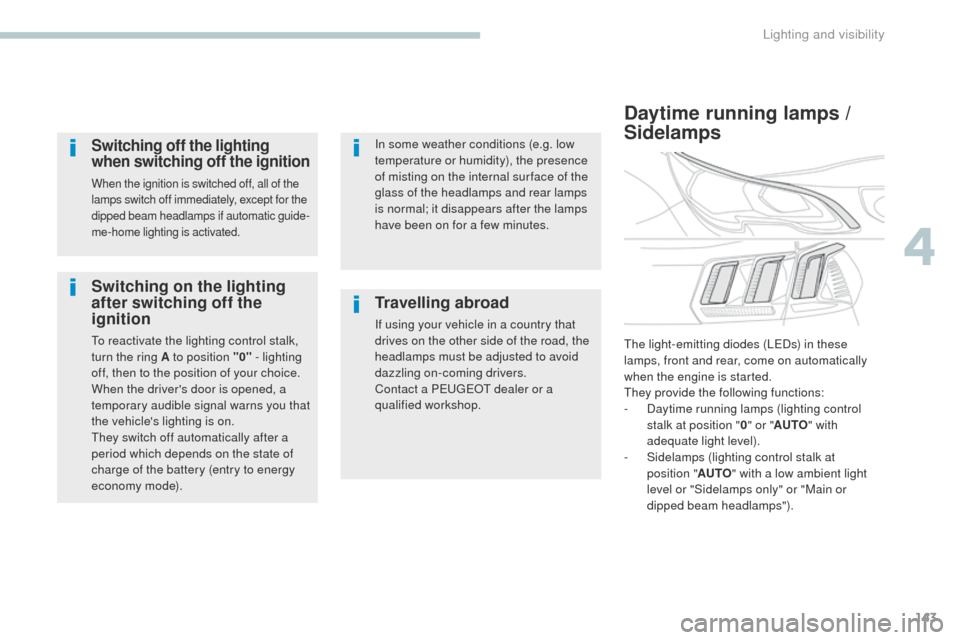
143
3008-2_en_Chap04_eclairage-et-visibilite_ed01-2016
Switching on the lighting
after switching off the
ignition
To reactivate the lighting control stalk,
turn the ring A to position "0" - lighting
off, then to the position of your choice.
When the driver's door is opened, a
temporary audible signal warns you that
the vehicle's lighting is on.
They switch off automatically after a
period which depends on the state of
charge of the battery (entry to energy
economy mode).
Daytime running lamps /
Sidelamps
The light-emitting diodes (LEDs) in these
lamps, front and rear, come on automatically
when the engine is started.
They provide the following functions:
-
D
aytime running lamps (lighting control
stalk at position " 0" or " AUTO " with
adequate light level).
-
S
idelamps (lighting control stalk at
position
"AUTO " with a low ambient light
level or "Sidelamps only" or "Main or
dipped beam headlamps").
In some weather conditions (e.g. low
temperature or humidity), the presence
of misting on the internal sur face of the
glass of the headlamps and rear lamps
is normal; it disappears after the lamps
have been on for a few minutes.
Travelling abroad
If using your vehicle in a country that
drives on the other side of the road, the
headlamps must be adjusted to avoid
dazzling on-coming drivers.
Contact a PEUGEOT dealer or a
qualified workshop.
Switching off the lighting
when switching off the ignition
When the ignition is switched off, all of the
lamps switch off immediately, except for the
dipped beam headlamps if automatic guide-
me-home lighting is activated.
4
Lighting and visibility